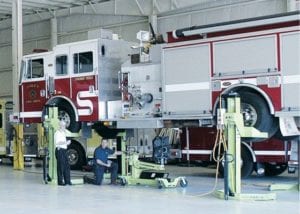By Frank R. Myers
Preventive inspections and maintaining everything from truck ladders to PPE may sound routine—until there’s a major problem. And once that problem occurs, the after effects in terms of litigation, reputation, and department disruption can be profound and long-lasting. How can you prevent this type of calamity?
It all starts with the morning inspection(s) after roll call and shift change. This is the time to assure your apparatus, power tools, hand tools, PPE, SCBA, etc. have been checked and viewed to ensure everything is in good working order. The unforeseen event cannot be avoided; events leading up to a mishap need to be sound and in place. Basically, a record and documentation of these important items showing that needed tasks are completed will confirm that you are operation-ready.
One event I remember was when Underwriters Laboratories would come out to test our ground ladders. They would use weights and measuring devices plus inspect the ladders to assure they were meeting the standards to stay in service. I also recall seeing them performing the “pump” tests, so they got their biannual certificates. Several times during the year, as with most departments, hose testing occurred (something everybody looked forward to—NOT!). This was a good time to train up-and-coming drivers.


To make sure you are abiding by all the requirements, have a proper system in place to track everything. Nothing requiring a scavenger hunt should get lost in the shuffle. Be able to show current status and location of assets at all times, on a moment’s notice.
This is monumental if litigation occurs for any reason. These could be: failure of a structural component to a ground ladder or aerial device; an accident during routine movements or an emergency call/alarm, or a malfunction of gear/equipment/tools, etc. It doesn’t matter if it happens to our members or to the public/civilians. It works in the best interest for all and for the municipality as a whole to be prepared and up to speed.
No matter what your job description is—ambulance, law enforcement, or fire-rescue—an accident can occur at anytime to anyone. Remember, litigators go for the “deepest pockets.” They are good at what they do and are very successful at it, or else they wouldn’t be in business.
To know what some of these statistics are, the National Highway Traffic Safety Administration (US Department of Transportation), publishes them in their reports. Here are some findings:
Ambulance Accidents in the US
The National Highway Traffic Safety Administration (NHTSA) released a report in April 2014 that provided an overview of the number of ambulance accidents in the United States. The agency studied the number of ambulance accidents over a 20-year period from 1992-2011. North-Western National also conducted a recent study of 466 ambulance accidents.
- There are an estimated 6,500 accidents involving ambulances each year.
- Thirty-five percent of crashes resulted in injury or fatality to at least one occupant of a vehicle involved.
- When injuries occur, there are, on average, three unique injuries per accident.
- On average, 29 fatal ambulance accidents produce 33 fatalities each year.
- On average, 2,600 people are injured in 1,500 ambulance accidents each year.
- Of those killed in an ambulance accident, 63 percent were occupants of a passenger vehicle; 21 percent were passengers in the ambulance; four percent were the ambulance drivers; and 12 percent were nonoccupants.
- Nearly 60 percent of ambulance accidents occur during the course of emergency use.
- Emergency medical personnel are at a higher risk of crashing when compared to other first responders.
Fire Truck Accidents in the US
According to data from the NHTSA and the United States Fire Administration (USFA), fire truck accidents are the second leading cause of on-the-job deaths for firefighters. Below are some key findings from an analysis of NHTSA data on firetruck accidents from 2000-2009:
- Over that 10-year period, there were roughly 31,600 accidents involving fire vehicles.
- Forty-nine of those accidents resulted in at least one fatality to an occupant of the fire truck.
- About 70 percent of all fire truck accidents occurred while in emergency use.
- Rollovers account for 66 percent of all fatal fire truck accidents.
Police Car Accidents in the US
In 2012, a police vehicle report found that, on average, a person is killed in a pursuit-related crash every day. Using data from 1994-2002, University of Washington researchers performed an analysis of the number of fatalities each year that occur during police pursuits. Below are some key findings:
- Each year, there are approximately 300 fatalities in the U.S. that occur during police pursuits.
- Just over 30 percent of the fatalities occurred to people who were not involved in the pursuit.
- Police officers have roughly double the rate of motor vehicle crashes per million vehicles driven as the general public.
It is obvious that these unfortunate events occur. Being up-to-date on checks and maintenance and being able to document it readily and accurately is of utmost importance. Otherwise, much hardship, monetary loss and unnecessary litigation that can damage careers, reputations and public perception can occur. “Slow down” and “be safe!”
FRANK R. MYERS is a retired Lieutenant with the City of Miami (FL) Fire Rescue, where he served 32 years. Before his retirement, he served at the Training Center for six years as the Driver Engineer Instructor. Frank now serves as a Senior Advisor for pstrax.com, a software platform that helps fire departments streamline and automate their apparatus, equipment, and narcotics programs. Frank Myers can be reached directly at [email protected] or 305-804-5177.
